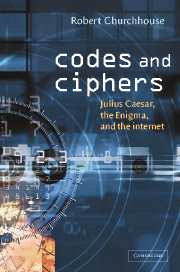Book contents
- Frontmatter
- Contents
- Preface
- 1 Introduction
- 2 From Julius Caesar to simple substitution
- 3 Polyalphabetic systems
- 4 Jigsaw ciphers
- 5 Two-letter ciphers
- 6 Codes
- 7 Ciphers for spies
- 8 Producing random numbers and letters
- 9 The Enigma cipher machine
- 10 The Hagelin cipher machine
- 11 Beyond the Enigma
- 12 Public key cryptography
- 13 Encipherment and the internet
- Appendix
- Solutions to problems
- References
- Name index
- Subject index
2 - From Julius Caesar to simple substitution
Published online by Cambridge University Press: 13 August 2009
- Frontmatter
- Contents
- Preface
- 1 Introduction
- 2 From Julius Caesar to simple substitution
- 3 Polyalphabetic systems
- 4 Jigsaw ciphers
- 5 Two-letter ciphers
- 6 Codes
- 7 Ciphers for spies
- 8 Producing random numbers and letters
- 9 The Enigma cipher machine
- 10 The Hagelin cipher machine
- 11 Beyond the Enigma
- 12 Public key cryptography
- 13 Encipherment and the internet
- Appendix
- Solutions to problems
- References
- Name index
- Subject index
Summary
Julius Caesar ciphers and their solution
In the Julius Caesar cipher each letter of the alphabet was moved along 3 places circularly, that is A was replaced by D, B by E … W by Z, X by A, Y by B and Z by C. Although Julius Caesar moved the letters 3 places he could have chosen to move them any number of places from 1 to 25. There are therefore 25 versions of the Julius Caesar cipher and this indicates how such a cipher can be solved: write down the cipher message and on 25 lines underneath it write the 25 versions obtained by moving each letter 1, 2, 3, …, 25 places. One of these 25 lines will be the original message.
Example 2.1
The text of a message enciphered by the Julius Caesar System is
VHFX TM HGVX
Decrypt the message.
Solution
We write out the cipher message and the 25 shifted versions, indicating the shift at the left of each line (see Table 2.1), and we see that the cipher used a shift of 19, for the cipher text is shifted 7 places to give the plain and this means that the plaintext has to be shifted (26–7) = 19 places to give the cipher. It looks very likely, on the assumption that no other shift would have produced an intelligible message, that we have correctly decrypted the message and so there is no point in writing out the remaining lines.
- Type
- Chapter
- Information
- Codes and CiphersJulius Caesar, the Enigma, and the Internet, pp. 13 - 27Publisher: Cambridge University PressPrint publication year: 2001



